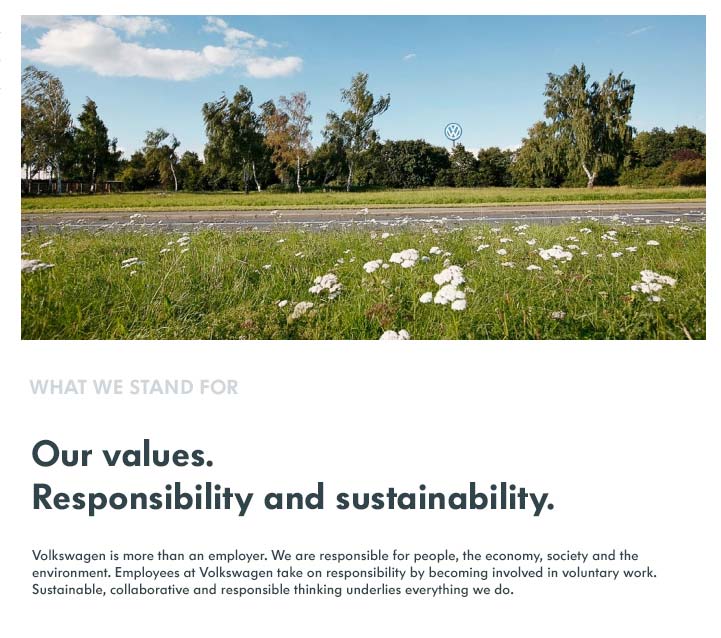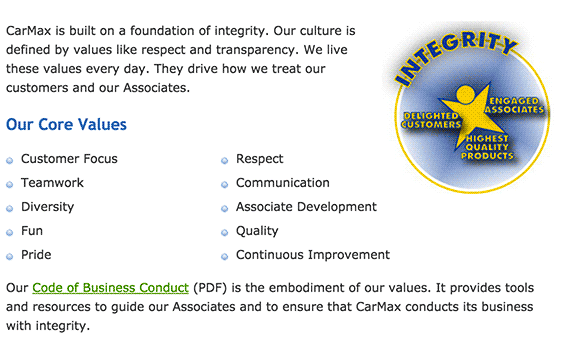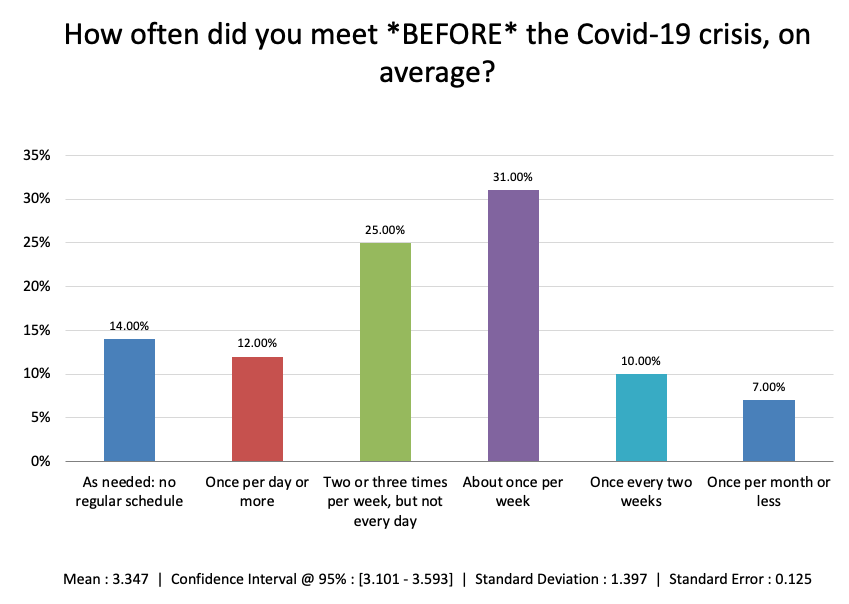Strategic Planning Part 4: How to Define Organizational Values
This post is the fourth in a series. You can find the whole series in our Complete Toolkit for Strategic Planning with Remote Teams.
When an organization’s values appear as guiding principles, a code of conduct, or a culture code that explains how the organization intends to operate in accordance with those values, a values statement makes a promise.
You can read Volkswagen’s published corporate values on their website:

A values statement promises that this organization chooses to champion good. That they reject corruption, sloth, waste and complacency.
A values statement promises that this organization will not suffer evil.
But we all know words are cheap, the proof is in the pudding, actions speak louder than words, etc. When an organization’s actions show their values statement to be only so much wasted ink, we know they operate without integrity and take our business elsewhere.
How Values Fit Into Strategic Planning
The Complete Toolkit for Strategic Planning with Remote Teams walks a team through defining organizational values.
As part of a strategic plan, your values inform and constrain the kind of strategies you choose to achieve your strategic goals. Values put guard-rails on your plan. If you develop your strategies without regard to your organizational values, you may find faster and easier ways to achieve your goals, but you risk breaking the promise of your values statement and operating without integrity.
For example, Volkswagen found they could have their cars lie to the EPA to pass emission tests, a strategy that effectively met the goal of passing the test but directly violates their values statement. This turned out to be a bad move.
“We’ve totally screwed up.”
VW America boss Michael Horn
https://www.bbc.com/news/business-34324772
Creating a Values Statement During the Strategic Planning Process
When we first began working through the Strategic Vision & Mission meetings in our test of the Essential Strategic Planning series, we ran into trouble.
We were trying to articulate a vision of the future we want to create with Lucid, something evocative that would provide a beacon to guide strategic decisions. Yet as we shared the results of our individual brainstorms about that vision, one by one we revealed concepts that spoke more to our shared values than our destination. Empowering, facilitative, inclusive, authentic – we were turning out a lot of phrases that described how it might feel when we achieved our vision, and how we wanted to go about it, but not much about where specifically we were headed. In fact, when we talked about what we felt made for a good vision statement, we all agreed that our vision would need to be aspirational, value-centric, and specific.
Clearly, we wanted to work on values first.
The problem with focusing on values first
I asked Anna about whether we should change the order of the templates, so that teams would start by defining their values before they worked on the vision. But Anna worked with government agencies and branches of larger companies in the past, where time spent crafting value statements can feel hollow. When you work as part of a much larger organization, your group’s operating values are supposed to mirror those of the parent organization, which makes defining them separately a bit weird.
A group that already has a value statement to work with might spend some quick time revisiting this statement before setting goals, as the 3rd step in the 5 step planning process. They might also just skip this part of the process entirely, and run with what they have.
The challenge of defining values as a team
There’s a final problem with this phase in planning: value statements created by committee sound lifeless. How is it useful to American Express, CarMax, Teach for America, and Barnes & Noble all to simply list “Teamwork” in their values? How does it impact the way they work each day, specifically? Or how they hire or fire?

Values-by-committee is, of course, exactly what the Defining Values template helps you do. You and your team brainstorm your values and come to a general consensus on which ones matter to you most. And they will most probably sound uninspiring, and that’s ok. Just don’t stop there.
We still think you should run this meeting as part of crafting your value statement, but you may want to adjust and supplement it. Read on.
Recommended Approach for Crafting a Brand-New Values Statement
If your organization is fairly new or you don’t have an existing values statement, here’s what we recommend.
- Read Kayako’s blog post on creating a corporate values statement.
Of all the resources we found, this is my favorite. You’ll get a feel for what does and doesn’t work in this process, and links to all kinds of great resources.
Capturing and Scaling Startup Values: How leaving our values unclear started breaking our culture, how we fixed it and what we learned - Make defining your values the first step in your strategic planning process.
We found that the rest of the strategic plan came together much more easily once we had this foundation in place. - Follow the process described in the Strategic Planning: Values template to create the first draft.
You and your leadership team will brainstorm, discuss, and agree on a set of core values concepts you all believe to be important to how your organization operates. - Then, the founders should go out.
Take a long walk, or go for lunch. Dig into your values more deeply. What do those concepts really mean to each of you? Explore examples:- What would it look like when someone demonstrated each value?
- What would it look like when they failed to live up to a value?
- What would you do as founders when someone in your organization acted contrary to the values?
- What would you expect to happen if you, as the leader, acted outside the values?
- Is that value still important enough to make the list? Does it really define your aspirations for your organizational culture?
- Assign one person to write the final values statement.
We agree entirely with the team at Kayako. The final statement cannot come from a committee if you want it to resonate. - Share, discuss, iterate.
Share this final statement with your team, and talk about what it means. Use it to frame your strategic planning, and refine your values statement as you learn by testing each strategy for fit.
Building Guiding Principles from Value Statements
If your team already has a basic value statement, take this opportunity to build guiding principles based on those value statements.
A guiding principle states the core value, then explains what the organization will do to stay in integrity with that value. If you’re part of the start-up world, a “culture code” serves the same function.
The team at Leadership Strategies outlines how to do this well in their post on Facilitating Guiding Principles
Several steps in the Leadership Strategies process ask the team to brainstorm: identifying desired behaviors, undesirable behaviors, etc. For a remote team, use an online brainstorming tool to support the group during this part of the process.
Example Company Value Statements
Ready to get started, but need some examples more inspiring than Volkswagen’s? You’re in luck! Peruse examples from these companies to see some radically different approaches, then get to work. What promise will your organization make?
- Moz
- The Honest Company: Our Principles
- Coca Cola: LIVE OUR VALUES
- Netflix Culture deck
- Starbucks Mission & Values
- Earth watch Mission and Values
- Aetna Values
- Zappos
- Merck Values
- P&G – Purpose, Values and Principles
- Atlassian
- HSBC Values
-
And more! Company Culture: An Inside Look At 100 Core Values From 15 Winning Companies
Ready to dive in? Read other posts in this series, download meeting agendas, and get the meeting templates here.
The next post in this series: Goals and Strategies



